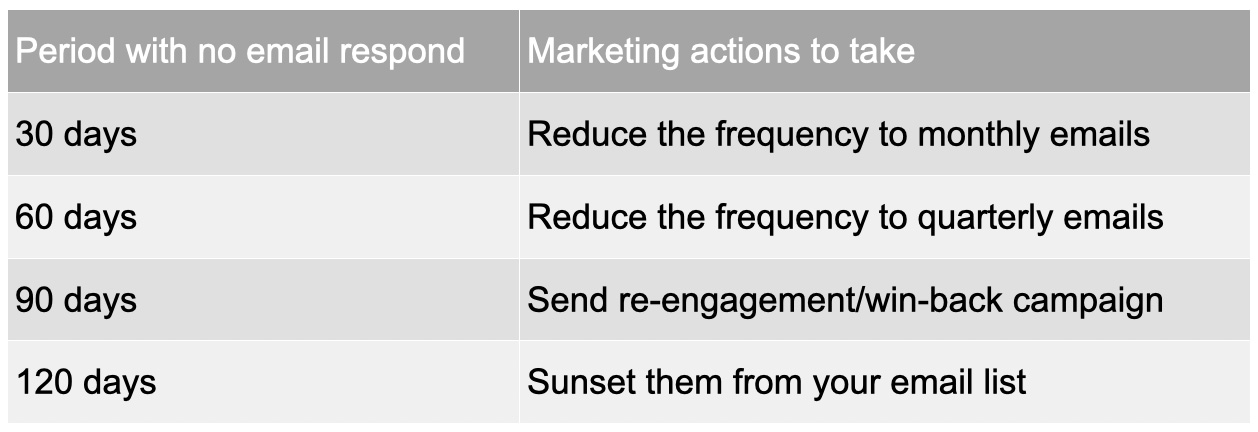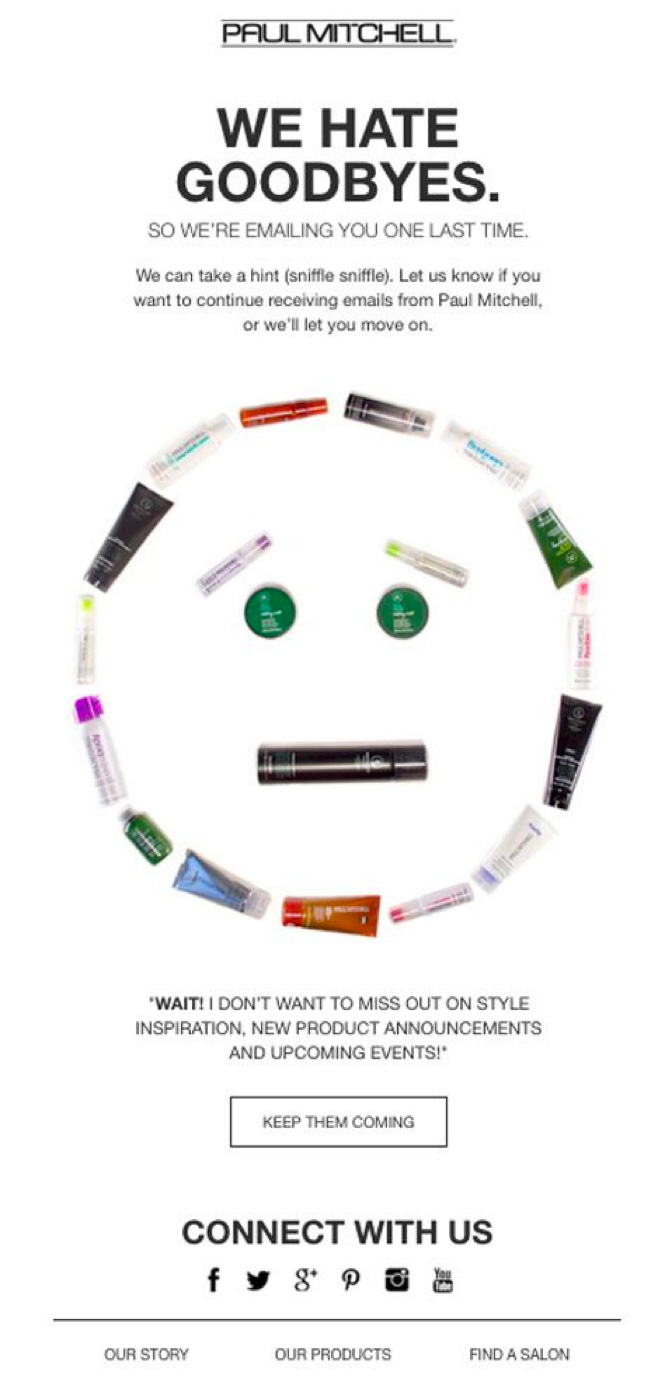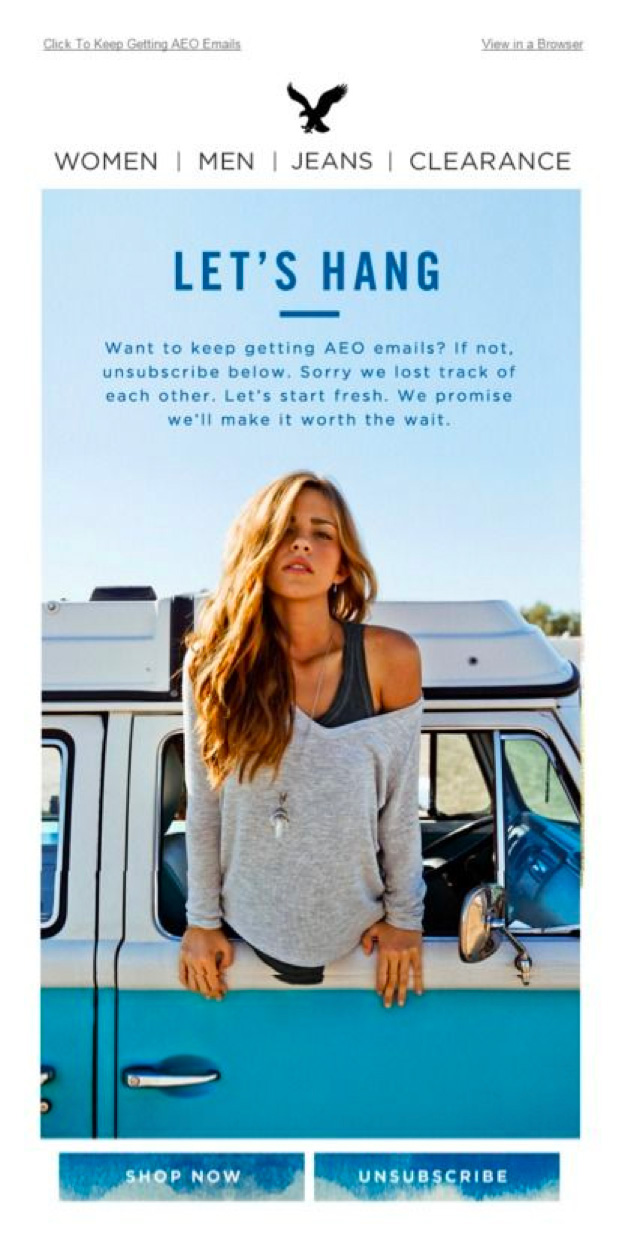Engaging customers is a critical aspect of business success, as it helps to build strong relationships with customers and increase loyalty. However, if you do not maintain a healthy active email list, your email marketing will likely suffer poor response rate. Today, let’s talk about an important topic – the email sunset policy. It is an important tool for organizations looking to optimize their email marketing and ensure compliance with legal and regulatory requirements. By setting clear guidelines for email data retention, organizations can reduce costs, improve performance, and maintain compliance with applicable laws and regulations.
What is email sunset policy?
Email sunset policy is a marketing strategy that automatically removes email subscribers who have not participated or cannot be reached for a long time from the email list. The main purpose of this policy is to ensure that the subscribers in the email list are active, improve the email open rate and click-through rate, and reduce spam and unsubscribe rates. The goal of this strategy is to enable businesses to focus more on communicating with engaged customers while removing those who are no longer participating, thereby improving the participation rate and delivery rate of emails.

Why is implementing the email sunset policy important?
The implementation of the email sunset policy is crucial for businesses’ email marketing. Here are several reasons:
- Optimize the sending list
By regularly cleaning up the email list, businesses can ensure that they only send emails to those who are truly interested, thereby improving the participation rate and the chance of entering the inbox. - Convenient list cleaning
The email sunset policy can make it easier for businesses to clean up the email list. It can help businesses identify subscribers who are no longer interested or do not want to receive emails and promptly remove them from the list. This can keep the list clean and lean, reducing the likelihood of sending spam. - Structured list cleaning
The email sunset policy can help businesses clean up the email list in a more organized way. It can clean the list based on fixed time intervals or specific criteria, such as subscribers who have not participated. This structured cleaning can help businesses regularly check and fix the list, rather than waiting until the list grows to an uncontrollable size before taking action. - Improve email delivery rate
Email service providers use engagement metrics, such as open rate and click-through rate, to determine if your email is relevant to the recipient. If your email is frequently unopened or deleted without being read, this can damage your sender reputation and reduce your email deliverability. If too many inactive subscribers mark the emails sent by businesses as spam or unsubscribe, the delivery rate of emails may be affected. By regularly cleaning up the list, businesses can ensure that they only send emails to those who are truly interested, thereby improving the delivery rate.How soon should you remove subscribers varies for different businesses, and it also depends on your email sending frequency. Typically for a retail brand that sends regular weekly emails, it is reasonable to remove subscribers if they have not open or engage with your emails after 6 months. Hence, you can set the rules as below example:
- They save costs
Sending emails to inactive customers actually incurs costs for sending messages that won’t generate any investment returns. By removing inactive customers, businesses can save costs and focus on interacting with customers interested in their brand. - They maintain compliance
If businesses send emails to customers in the European Union, they need to comply with GDPR (General Data Protection Regulation) rules, which require obtaining explicit consent from recipients and providing a simple unsubscribe method. By removing inactive customers, businesses can ensure that they do not send emails to customers who have not given their consent.

How to implement the email sunset policy?
The email sunset policy is essential for businesses, but before implementing this policy, businesses need to consider some steps to ensure its effectiveness. Here are the steps that businesses need to consider before implementing the email sunset policy:
- Identify the target audienceBusinesses need to identify their target audience based on their business needs and the characteristics of their target audience. This can help businesses better understand their audience and execute the sunset policy more effectively.
- Determine the cleaning frequencyBased on the business needs and the characteristics of the target audience, businesses need to decide how often they want to clean their list. This can help businesses clean their list at the right time and ensure that their list is always up-to-date and effective.
- Create a list of non-engaging subscribersBased on the cleaning frequency and criteria, businesses need to create a list of non-engaging subscribers. For example, subscribers who have not opened emails in the past six months can be included in the list. This can help businesses better understand their non-engaging subscribers and be prepared to execute the sunset policy.
- Send a re-engagement emailBefore removing these subscribers from the list, businesses can try sending a re-engagement email, inviting them to re-engage with the business’s emails. This may encourage some subscribers to re-engage with the business’s list, thereby increasing the email open rate and click-through rate.
- Remove non-engaging subscribersAfter waiting for a period of time, businesses need to remove those subscribers who are still not engaging with the business’s list. This can help businesses maintain the quality and accuracy of their list, and ensure that their list is always up-to-date and effective.
Ultimately, implementing the email sunset policy requires businesses to consider multiple steps, including identifying the target audience, determining the cleaning frequency, creating a list of non-engaging subscribers, sending a re-engagement email, and removing non-engaging subscribers. By following these steps, businesses can better understand their audience and clean their list at the right time, thereby increasing the email open rate and click-through rate, reducing spam and unsubscribe rates, and increasing their revenue and conversion rates.
How to implement the email sunset policy using email marketing tools?
As email marketing becomes increasingly popular, implementing the email sunset policy has become a necessary measure to maintain the high quality and effectiveness of email lists. Here are some simple steps:
- Segment your email list using marketing tool based on last purchase date or email open date. This can help businesses better understand their audience and clean their list at the right time.
- Create a list of non-engaging subscribers based on cleaning frequency and criteria. This can help businesses better understand their non-engaging subscribers and be prepared to execute the sunset policy.
- Send a re-engagement email inviting non-engaging subscribers to re-engage with the business’s emails. This can be achieved by creating a special email template and adding specific text and links. For example, a “re-subscribe” button can be added to let subscribers confirm their subscription. This step can help businesses re-activate some subscribers and increase the chances of email engagement and inbox entry.

- Wait for a period of time, such as a week or two, to see if these subscribers re-engage with the business’s emails. This can help businesses better understand their audience and clean their list at the right time.
- Remove those subscribers who are still not engaging with the business’s list. This can be achieved by selecting the list of non-engaging subscribers in the email marketing tool and deleting them. This can help businesses maintain the quality and accuracy of their list, and ensure that their list is always up-to-date and effective.
In summary, an email sunset policy is an important tool for organizations looking to optimize their email marketing effectiveness and ensure compliance with legal and regulatory requirements. By setting clear guidelines for email data retention, organizations can reduce costs, improve performance, and maintain compliance with applicable laws and regulations. Above all, companies provide better customer experience and brand loyalty.




